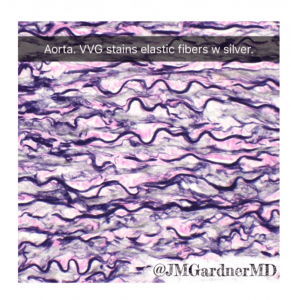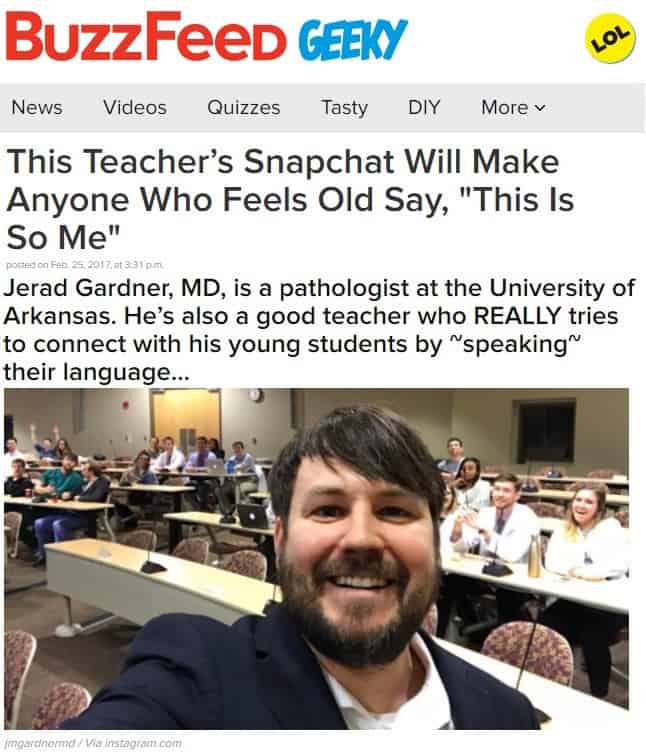Educator Draws Attention of BuzzFeed for Using Social Media to Engage Students
| March 14, 2017 | A University of Arkansas for Medical Sciences (UAMS) educator caught the attention recently of BuzzFeed, a global media company, for using Snapchat to engage his medical students.
BuzzFeed produces and distributes original news, entertainment and video, reaching a global audience of over 7 billion content views.
Jerad M. Gardner, M.D., is an assistant professor of pathology and dermatology in the UAMS College of Medicine.

Many of Gardner’s social media posts — like this snap — are pictures of interesting cases at the microscopic level.
“He’s also a good teacher who REALLY tries to connect with his young students by speaking their language,” BuzzFeed noted in a Feb. 25 post that featured several colorful pathology slides Gardner had shared.
Gardner, also a bone and soft tissue sarcoma pathologist and director of the dermatopathology fellowship program, routinely uses social media – including Facebook, Twitter, Instagram and YouTube – to supplement his courses, work with patients, conduct research and connect with students and professionals interested in medicine from all over the world.
He runs social media for several pathology professional organizations and leads trainings for his peers on how social media can improve their impact as educators.
Reaction to the BuzzFeed article “filled my Facebook timeline for days,” Gardner said, adding that he welcomes the attention it brings to his field, UAMS and the use of social media in education.
“Everyone knows about BuzzFeed,” Gardner said. “Certainly, I’ve never had that kind of exposure or interest in the past. Pathology is kind of an obscure field, and a lot of people don’t even know what we do.”
Pathologists diagnose cancer and other diseases, typically by examining tissue samples from patients microscopically. Many of Gardner’s social media posts are pictures of interesting cases at the microscopic level, especially in his specialty area of rare bone, soft tissue and skin cancers. He shows students how to diagnose different conditions with photos, links and videos.

Gardner also shows students how to diagnose different conditions with photos, links and videos via social media.
“I feel like anything you’re trying to do as an educator, you can do it better and more efficiently and more broadly with social media than you could do without it,” Gardner said. “It doesn’t replace any of your normal activities. You still treat patients; you still teach lectures; you still do research and write papers – all of that – but social media can take the things you already do and magnify the impact tenfold.”
The BuzzFeed article highlights Gardner’s most recent efforts to expand his use of social media in education to include Snapchat, which is a photo- and video-based mobile app popular with younger audiences. The article, “This Teacher’s Snapchat Will Make Anyone Who Feels Old Say, ‘This Is So Me,’” begins with one of Gardner’s first snaps, in which he makes a joke about feeling old as he adjusts to the new platform, and then shows some of his other snaps of skin biopsies and normal tissues at the cellular level.
Gardner encourages educators to embrace the feeling of discomfort – including “feeling old” – that comes from adjusting to new social media, urging them to “follow where the people are.”
“It’s a bridge to the younger generation who are going to take over our field one day, and we should have an influence on them and embrace the chance to mentor them,” Gardner said.
He started two discussion groups – one on skin pathology, or dermatophathology, and another on bone and soft tissue cancers (sarcomas). They each now have 25,000 and 18,000 members, respectively, including doctors and students from all over the world.

Gardner says educators should meet younger audiences where they are — and online, that’s on Snapchat.
He volunteers to answer questions in patient support groups, usually helping with things like understanding the language on a pathology report or navigating the medical system from diagnosis to treatment. Gardner said that interacting with patients online has been life changing and he now recommends all medical students do the same.
“Just to sit and listen and learn from patients, I think it creates a tremendous amount of empathy and understanding of their perspective,” Gardner said. “It has made me a better doctor for sure, and it has made me even more committed to educating them and communicating with them in language everyone can understand.”
Gardner has used social media to conduct research, surveying academics about how they use social media in education and gathering data from patient groups about treatment outcomes. His YouTube channel features instructional videos filmed with pathology slides and recordings of his lectures.
Gardner’s social media use has also helped him network and collaborate with other scientists. He has given about 35 invited talks on social media use for professionals in the past three years.
“I think social media is here to stay, so it would be better for us to understand how it’s being used and harness that in a way that would be useful educationally,” Gardner said.
“And if we find out people are turning to social media as a source, then we better make sure that we’re providing reliable content on that source. That’s kind of our wider purpose as educators. I think if we stick our heads in the sand, social media is going to continue without us, but we’ll be left with no say in it, and we will have missed an opportunity to influence the next generation.”
UAMS is the state’s only health sciences university, with colleges of Medicine, Nursing, Pharmacy, Health Professions and Public Health; a graduate school; a hospital; a main campus in Little Rock; a Northwest Arkansas regional campus in Fayetteville; a statewide network of regional campuses; and eight institutes: the Winthrop P. Rockefeller Cancer Institute, Jackson T. Stephens Spine & Neurosciences Institute, Harvey & Bernice Jones Eye Institute, Psychiatric Research Institute, Donald W. Reynolds Institute on Aging, Translational Research Institute, Institute for Digital Health & Innovation and the Institute for Community Health Innovation. UAMS includes UAMS Health, a statewide health system that encompasses all of UAMS’ clinical enterprise. UAMS is the only adult Level 1 trauma center in the state. UAMS has 3,485 students, 915 medical residents and fellows, and seven dental residents. It is the state’s largest public employer with more than 11,000 employees, including 1,200 physicians who provide care to patients at UAMS, its regional campuses, Arkansas Children’s, the VA Medical Center and Baptist Health. Visit www.uams.edu or uamshealth.com. Find us on Facebook, X (formerly Twitter), YouTube or Instagram.###
